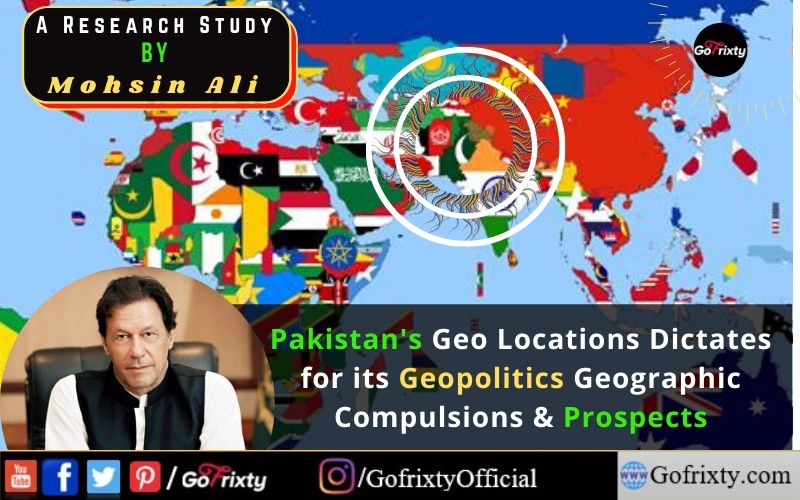Abstract
Sub-Continent comprises of seven states (India, Pakistan, Bangladesh, Nepal, Bhutan, Sri Lanka, and the Maldives). Over the total area of South Asia, which is 5,134,641, square kilometres, Pakistan covers 881,913 square kilometres (including Indian Occupied Kashmir). Pakistan is ranked 2nd in South Asia and 33rd on the globe, concerning the area. It is 2nd biggest population of South Asia and ranked as the 5th biggest population of the world. Pakistan due to its geopolitical and geostrategic location has been the centre of focus for power players of the world.
With the wind-up of ideological war between the United States and the Soviet Union and the fall of later (Soviet Union) and annihilation of communist ideology, the chances of a global war have decreased, but tensions in the global context and regional frictions have not mitigated. The unipolar world has been susceptible to compulsion through expulsive and economic diplomatic manoeuver. Regrettably, in contemporary times, hostilities conducted by the United States of America along with western bloc against the Muslim world have increased. The global context is in continuous change with dynamic geostrategic and geopolitical preferences. With the end of the bipolar world and the advent of unipolar with the United States as a sole superpower, standard amends within the significance of geo-economics, geo-strategy, influencing part of non-state actors, Islamophobia, Nuclear non-proliferation, numerous other issues have entailed a re-conceptualization of state-to-state correspondence.
Pakistan being most important due to its geostrategic and geopolitical location has formulated its preferences and manage relations with other regional and exterritorial states. It is solely up to Pakistani’s to utilize and manipulate the ball game to the greater good of their country.
Keywords
-
Geo-political
Associated with International Politics in terms of Geographic location.
-
Geostrategic
Associated with strategic resolutions of geopolitical affairs.
-
Geo-graphic
In terms of somatic attributes of territory on the Earth.
-
National interests
It is the most indistinct term in international relations and consequently taken liberties with, peculiarly by the political elite. This notion grabbed the scholar’s attention after World War II (Martin Griffiths, 2007). It means ceaselessness of the preservation of physical, political, and ethnic recognition against infiltrations by other states.
-
Compulsions
The act or situation of constraining or being constrained to carry out some task.
-
Challenges
A cut-throat situation or a decisive brawl in terms of capacity, capability, and potentiality.
-
Natural Recourses
Stockpile, which exists without any endeavour of mortals
Introduction
Pakistan came into existence after the division of colonial India, which was ruled by the United Kingdom, into two independent states (India and Pakistan) in 1947 on the foundation of the two-nation theory, following the climax of World War II. Right from the year of independence both the successor states have conflicted over the Territory of Jammu and Kashmir and have indulged in four major wars (The First Kashmir War 1947-48, Second Kashmir War 1965, Indo-Pakistani War 1971 and Kargil Conflict 1999) and numerous border engagements. Pakistan (latitude: 23⁰ 35’ to 37⁰ 05’ north. Longitude: 60⁰ 50’ to 77⁰ 50’ minutes east) borders with India, China, Afghanistan, and Iran.
Also read ???? An analysis of Industrial Policies of Pakistan 1972-1977 | Bhutto Regime
Pakistan reposes in the temperate zone, in the north of tropic of Cancer, so the climate is more often than not arid, distinguished by hot summers and chilly winters, and wide range of dissimilarities between utmost temperatures at specified whereabouts. This is the reason, in southern Pakistan, there are deserts like; Thar, Kharan, Thal, and the Cholistan, while in the northern Pakistan rain forests can be observed. Pakistan is rich in natural resources including agricultural territory, forests, minerals, animal resources, sea, and rivers. Pakistan shares its border with the Arabian Sea in the south which is strategically important as it is connected with the Persian Gulf and Indian Oceans. Pakistan is blessed with having deepest seaport in the world, Gwadar port, which is not more than 500 nautical miles away from Strait of Hormuz.
Compared to the other South Asian States, Pakistan is privileged with a more significant geostrategic location as it furnishes a direct avenue to energy-rich Iran and Central Asian Republics and is situated at the junction of the continents. Pakistan plays a fundamental role in projects like CPEC (China Pakistan Economic Corridor), CASA (Central Asia South Asia Electricity Transmission), IPI (Iran Pakistan India gas pipeline), APTTA (Afghanistan Pakistan Transit Trade Agreement), TAPI (Trans Afghan Pakistan India gas pipeline), and other energy and trade agreements.
Questions
- What is the geostrategic location of Pakistan?
- What are the geostrategic compulsions on Pakistan?
- How can Pakistan peruse its national policy while facing those compulsions?
Background
Pakistan due to its geographic, geopolitical, and geostrategic location has played a chief role on the global scene since 1947 and the Foreign Policy of Pakistan has been steered by these factors. Situated at Carrefour of the Middle East and South Asia, reasonably adjacent to the USSR and Europe, Pakistan transpired as a prospective link between Persian Gulf, East Asia, and the West, besides a passage to Muslim World. Soon after independence, the government encountered an obstacle to secure survival and to get grips with power imbalance in the region while lacking supplies and gadgetry.
This requirement impelled Pakistan to look towards the United States of America. The US provided aid to Pakistan for development and strengthening its military profile and in return it demanded Pakistan to be a part of an alliance of Asian countries to hold back Soviet expansionist policies in Asia. Pakistan became a part of SEATO 1954 after signing Mutual Defense Assistance Agreement and CENTO in 1955. By CENTO Pakistan also developed a friendship with Muslim states like Iran and Turkey.
Also Read: What’s the best way to Invest in your 20s | Case Study
By 1957, Pakistan had developed its military strength by supplying arms, military technology, including hi-tech long-distance radars, tanks, helicopters, frigates, and Gazi submarine. In exchange, the US acquired territorial privileges and stationed its top-secret surveillance base in the disguise of a transmission centre close by Peshawar to trace Soviet and Chinese schemes.
This alliance projected not a very good image of Pakistan and it was then looked on as “messenger of imperialist powers” by the Islamic World especially by Egypt, the Kingdom of Saudi Arabia, and Afghanistan. Most importantly this alliance did not receive positive public feedback. This alliance brought heavy consequences in the form of a breakup of Pakistan in 1971 when India was heavily supported by the Soviet Union while the US ignored Pakistan. After the 1971 war Soviet Union tried to escalate tensions between Afghanistan and Pakistan over the Pushtoonistan issue.
In 1979 Soviet-Afghan War Pakistan played a key role. Instantly after the Soviet-Afghan War, the US provided back door support to Mujahidin by supplying military aid, training, funding, and equipping them with state of art gadgetry with the help of Pakistan. ISI and CIA managed training camps in tribal areas where they provided guerilla and weapon handling training to Mujahidin. This war continued until the disintegration of the Soviet Union in 1989.
Right after the crises of 9/11, terrorism had become a dilemma in international relations and world politics. With the rise of terrorist organizations like al-Qaeda and the Taliban, global peace had come to the verge of destruction. The US held al-Qaeda accountable for the 9/11 attacks and pioneered a crusade against them and Pakistan became a non-NATO organ to US-marshalled “War on Terror”. Compared to other members, Pakistan’s contributions played a significant role in this campaign in the matter of access: sea, land and air, surveillance, planning, and execution.
Association with the Global War on Terror received a negative response from the public of Pakistan as well. Pakistan became a breeding ground for proxy warfare due to numerous extraneous influences. Terrorist organizations attempted to stimulate sectarian and public divisions.
Pakistan stationed a whole slew of troops along the Durand line to aid “Operation Enduring Freedom” and engaged a greater proportion of its logistical supply to keep-up the alliance. OEF received significant support from the international community and Pakistan also cleared its image at the international scene.
Prevailing Conditions
History of Pakistan is full of adventures and endeavours to attain stability and maximize its security to protect its sovereignty, counter Indian hegemony in the region and deter prevailing threats by counterparts. But endeavours and adventures have not come to an end as Pakistan is still struggling with various challenges due to its geostrategic location.





I am often to blogging and i really appreciate your content. The article has really peaks my interest. I am going to bookmark your site and keep checking for new information.